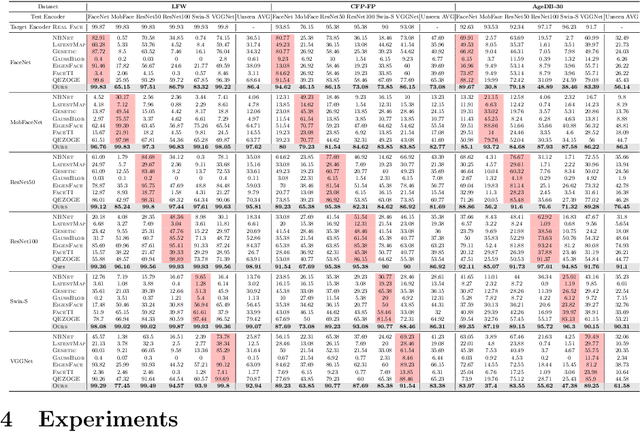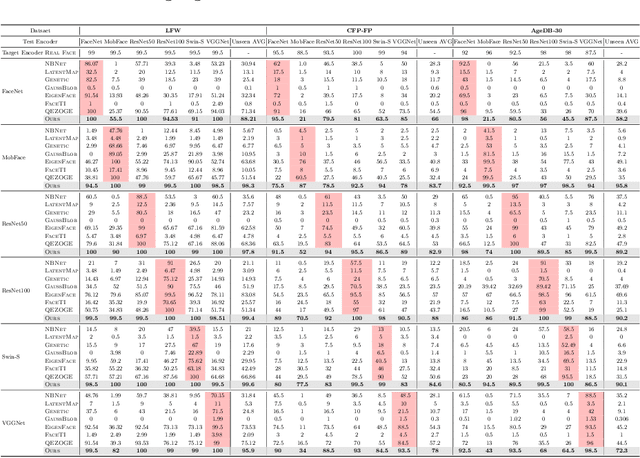Hojin Park
Face Reconstruction Transfer Attack as Out-of-Distribution Generalization
Jul 02, 2024



Abstract:Understanding the vulnerability of face recognition systems to malicious attacks is of critical importance. Previous works have focused on reconstructing face images that can penetrate a targeted verification system. Even in the white-box scenario, however, naively reconstructed images misrepresent the identity information, hence the attacks are easily neutralized once the face system is updated or changed. In this paper, we aim to reconstruct face images which are capable of transferring face attacks on unseen encoders. We term this problem as Face Reconstruction Transfer Attack (FRTA) and show that it can be formulated as an out-of-distribution (OOD) generalization problem. Inspired by its OOD nature, we propose to solve FRTA by Averaged Latent Search and Unsupervised Validation with pseudo target (ALSUV). To strengthen the reconstruction attack on OOD unseen encoders, ALSUV reconstructs the face by searching the latent of amortized generator StyleGAN2 through multiple latent optimization, latent optimization trajectory averaging, and unsupervised validation with a pseudo target. We demonstrate the efficacy and generalization of our method on widely used face datasets, accompanying it with extensive ablation studies and visually, qualitatively, and quantitatively analyses. The source code will be released.
Open-Set Face Identification on Few-Shot Gallery by Fine-Tuning
Jan 05, 2023Abstract:In this paper, we focus on addressing the open-set face identification problem on a few-shot gallery by fine-tuning. The problem assumes a realistic scenario for face identification, where only a small number of face images is given for enrollment and any unknown identity must be rejected during identification. We observe that face recognition models pretrained on a large dataset and naively fine-tuned models perform poorly for this task. Motivated by this issue, we propose an effective fine-tuning scheme with classifier weight imprinting and exclusive BatchNorm layer tuning. For further improvement of rejection accuracy on unknown identities, we propose a novel matcher called Neighborhood Aware Cosine (NAC) that computes similarity based on neighborhood information. We validate the effectiveness of the proposed schemes thoroughly on large-scale face benchmarks across different convolutional neural network architectures. The source code for this project is available at: https://github.com/1ho0jin1/OSFI-by-FineTuning
Understanding Open-Set Recognition by Jacobian Norm of Representation
Sep 23, 2022



Abstract:In contrast to conventional closed-set recognition, open-set recognition (OSR) assumes the presence of an unknown class, which is not seen to a model during training. One predominant approach in OSR is metric learning, where a model is trained to separate the inter-class representations of known class data. Numerous works in OSR reported that, even though the models are trained only with the known class data, the models become aware of the unknown, and learn to separate the unknown class representations from the known class representations. This paper analyzes this emergent phenomenon by observing the Jacobian norm of representation. We theoretically show that minimizing the intra-class distances within the known set reduces the Jacobian norm of known class representations while maximizing the inter-class distances within the known set increases the Jacobian norm of the unknown class. The closed-set metric learning thus separates the unknown from the known by forcing their Jacobian norm values to differ. We empirically validate our theoretical framework with ample pieces of evidence using standard OSR datasets. Moreover, under our theoretical framework, we explain how the standard deep learning techniques can be helpful for OSR and use the framework as a guiding principle to develop an effective OSR model.
 Add to Chrome
Add to Chrome Add to Firefox
Add to Firefox Add to Edge
Add to Edge